Many chain food establishments are named after people, and I often find myself wondering who the hell these people are and are they pissed that their restaurants are serving terribly mass produced food? Maybe some people don’t have the wandering curiosity that I do, but these kind of things pop into my head. I decided to look into who a few of these people are.
Max & Erma’s
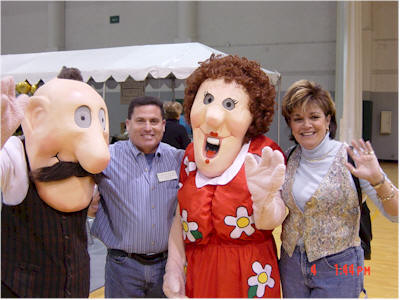
If Max could see this now, he would be pissed
Founders: Max and Erma Visocnik
The building that housed Max & Erma’s was built in 1889 by a brewing company. In 1958, Max and Erma Visocnik acquired the property and operated a bar catering to railroad and brewery workers. Intending to start a gourmet hamburger restaurant, Columbus businessmen Todd Barnum and Barry Zacks purchased the place from the Visocniks in 1972. Barnum and Zacks sketched out an agreement on a cocktail napkin in 1972 to purchase the bar from Max and Erma Visocnik, on the condition that Max would be allowed to drink free draft beer for the rest of his life After several months of renovation and redecorating, Barnum and Zacks opened their new restaurant but kept the old name: Max & Erma’s.
Wendy’s

Founder: Dave Thomas
Now I know that Wendy wasn’t really responsible for the fast food chain, Dave Thomas is. However, I wondered for years who this hideous looking red haired girl was on all of the signs. She’s the step-daughter you never want. Her actual name is Melina Lou Morse, former Melina Lou Thomas, and was Dave Thomas’ fourth born child. When Dave Thomas opened his first Wendy’s in Columbus, Ohio, he named the hamburger restaurant in honor of her. Wendy was a nickname given to Melinda Lou by her four siblings, and came to be the name that she preferred for herself. Within a few years, Wendy’s restaurants, and the image of eight-year old Wendy herself, became synonymous with the resturaunt. Wendy actually owned several of the restaurants in the Dallas area until 1999. Following Dave’s death in 2002, she entered the corporate side of the company and became more involved in the business side.
Bill Knapp’s
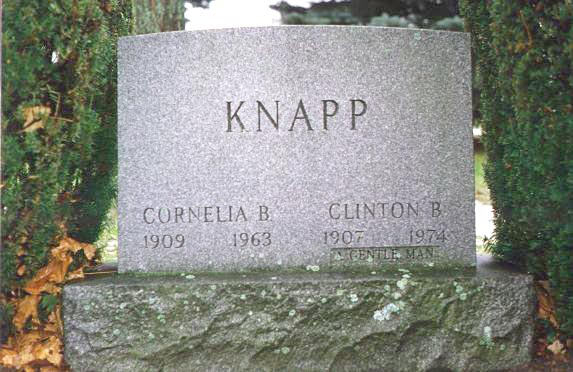
Bill Knapp's gravestone. It was the only thing I could find!
Founder: Bill Knapp, real name Clinton B. Knapp
Bill Knapp’s was a Michigan chain that closed down several years ago. I used to go there simply for the bean with bacon soup. It was off the jam. Bill Knapp was a traveling salesman in Cleveland who also enjoyed cooking and baking. Traveling so much, Knapp was always on the lookout for a good place to eat a meal. In 1947, the Knapp family moved to Battle Creek, where Knapp took a job with Shaefer Bakeries. But in the evenings at home, he worked on his concept for a new type of restaurant chain, including trying out various food dishes. His restaurant concept was simple and direct: Provide really good food, serve it quickly, and keep it reasonably priced.
He scraped together $10,000 along with four other local investors. The first Bill Knapp’s Restaurant opened in 1948 in Columbia, Michigan. Knapp’s concept was a hit. He soon opened a second restaurant in downtown Columbia, and by 1955 had three restaurants in Battle Creek, MI and others in Lansing, MI and Kalamazoo, MI. Knapp preferred to hire and train restaurant employees “from scratch,” Hill said, and he preferred they didn’t have previous restaurant experience. The restaurant chain began begin running into some financial issues in the 1990’s after not expanding.
Part of the reason Knapp’s had not expanded as a business is that its clientele remained mostly the same since 1948, and were sadly expiring, often in Bill Knapp’s restaurants. Some refer to it as a God’s Waiting Room or the Senior City. Ok, that was mean. Sorry. That’s not the reason it failed.
First, there was the disastrous attempt to reposition the place to appeal to the missing young adults, with clashing paint colors, video games, loud music, and a dumb new slogan of “That was then — this is wow!” They drove away their core customers and (no surprise) failed to attract any young people.
Then sanity returned. The management scrambled — with obviously heartfelt apologies — to return to the old Bill Knapps and undo the damage. And the old customer base flocked back.
But restaurants operate on a thin profit margin. Revenue was back up again, but the months of losses had built a mountain of debt. So they went into Chapter 11 reorganization.
Wham! With news of the bankruptcy filing, all those “loyal customers” suddenly fled. Revenue dropped through the floor, and Bill Knapps was finished. Liquidation followed.
Carl’s Jr
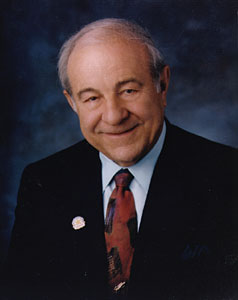
Founder: Carl Karcher
Carl Karcher dropped out of school after eighth grade to work on the farm where his father was a sharecropper. At 20, an uncle offered him work at his Karcher’s Feed and Seed Store in downtown Anaheim, where the young man was later offered a job by a customer who owned a bakery. Delivering baked goods, Karcher noticed that there were thriving hot dog stands everywhere, and decided there was money to be made selling “fast food”. He borrowed a few hundred dollars against his Plymouth, and purchased his first hot dog stand in 1941. Parked at the corner of Florence and Central in South Central Los Angeles, business boomed, and within a few years he had several hot dog carts. He then he opened his first full-service restaurant, Carl’s Drive-In Barbecue, in Anaheim in 1945. Eventually, Carl’s added hamburgers at several new, smaller locations, with the new restaurants dubbed Carl’s Jr. because they were scaled-down, smaller versions of Karcher’s first restaurant.
Devoutly Catholic, Karcher and his wife raised a dozen children. He often told reporters that he attended morning mass every day before going to the office, and began every company board meeting with the Pledge of Allegiance. Karcher was a lifelong member of the Republican Party and a staunch financial supporter of conservative causes. He contributed heavily to anti-abortion groups, and was the largest single contributor to a 1978 ballot initiative in California that would have required public schools in California to fire any teachers known to be gay or lesbian. To gauge how far on the conservative extreme Karcher was, the initiative failed after former Governor and soon-to-be President Ronald Reagan came out against it, citing it as too intrusive.
The late 1980s and 1990s brought trouble early-on and success later. Carl’s Jr. chains had struggled to gain success in Arizona and Texas, perhaps diminishing hopes of expansion to other states, though later states like Nevada, Oregon and Washington proved successful. During the 1990s Karcher and the Board of Directors began clashing over marketing and business practices, including the chain’s attempt at dual branding with such chains as The Green Burrito, which led to Karcher’s ousting as Chief Executive Officer in 1993. Soon after, the Board of Directors took a new approach by cutting the menu, lowering prices, and introducing a new marketing campaign which targeted younger urban and suburban males. During this time, commercials for Carl’s Jr. featured an animated caricature of Carl Karcher and the chain’s mascot, Happy Star.
Jimmy John’s
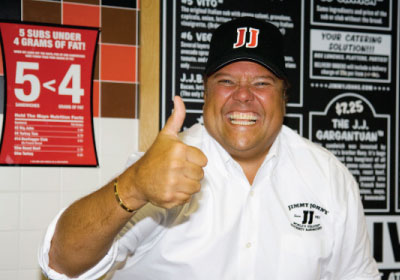
Founder: Jimmy John Liautaud
After founder Jimmy John Liautaud graduated second to last in his class from Elgin Academy in 1982, his options were joining the Army or starting a business. He chose to start a business. Inspired by Portillo’s, Liautaud’s father lent him $25,000 to start his own hot dog business. If the business was successful, Liautaud would own 52% of it and his father would own 48%. If it failed, he would join the Army.
After Liautaud realized starting a hot dog business would cost nearly twice the amount of the loan, he decided to open a sandwich shop instead. A nearby neighbor told Liautaud that the secret of a successful sandwich was in the bread. He started baking bread in his mother’s kitchen, bought the most expensive meats from Dominick’s, and had family members vote on the best four sandwiches (out of six) he created.
The first Jimmy John’s opened in a garage in Charleston, Illinois on January 13, 1983 with used equipment and no menu or outdoor advertisement, simply selling the four sandwiches and 25-cent Cokes. After giving samples out around town, his business began to thrive. He especially catered to college students at Eastern Illinois University. After two friends backed out as managers, he ran the store himself for the first few years, working seven days a week from open to close.
In April 1985, he bought out his father’s side of the business and became sole owner. He opened his second store in Macomb, Illinois, and, after manager William “Billy” Burns was killed in a car accident, he ran the second store himself for a few months. Liautaud went on to honor Burns by naming the “Billy Club” sandwich after him, which remains on the menu to this day. He would later open several more stores, and he developed a prototype before franchising began in 1993.
Tim Horton’s
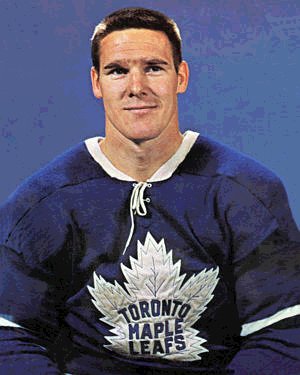
Founder: Tim Horton
The chain’s first store opened in 1964 in Hamilton, Ontario under the name “Tim Horton Donuts” (the name later being abbreviated to “Tim Horton’s”, and later still changed to “Tim Hortons” without the possessive apostrophe). The business was founded by Tim Horton, who played in the National Hockey League from 1949 until his death in a car accident in 1974.
Soon after Horton opened the store, he met Ron Joyce, a former Hamilton police constable. In 1965, Joyce took over the fledgling Tim Horton Donut Shop on Ottawa Street North in Hamilton. By 1967, after he had opened up two more stores, he and Tim Horton became full partners in the business. Upon Horton’s death in 1974, Joyce bought out the Horton family and took over as sole owner of the existing chain of forty stores. Joyce expanded the chain quickly and aggressively in geography and in product selection, opening the 500th store in Aylmer, Quebec, in 1991.
Ron Joyce’s aggressive expansion of the Tim Hortons business resulted in two major changes in the coffee and doughnut restaurant market: independent doughnut shops in Canada were virtually eliminated, and Canada’s per-capita ratio of doughnut shops surpassed those of all other countries.
By the 1990s, the company name had changed to The TDL Group Ltd. This was an effort by the company to diversify the business, removing the primary emphasis on doughnuts. In March 2006, the company went public.
Some older locations retain signage with the company’s name including a possessive apostrophe, despite the fact that the official styling of the company’s name has been Tim Hortons, without an apostrophe, for at least a decade. The company had removed the apostrophe after signs using the apostrophe were considered to be breaking the language sign laws of the Province of Quebec. The removal of the apostrophe allowed the company to have one common sign image across Canada.
